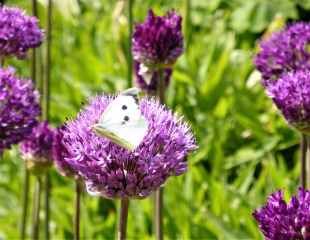

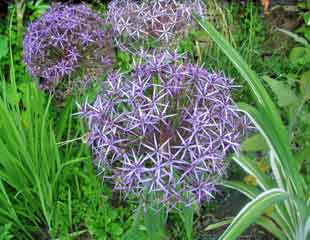
Allium Growing Guide:
Care, Planting Combinations & Varieties for Your Garden
Alliums are easy-to-grow perennial bulbs.
Alliums bring style to the garden with their tall, globe-shaped flowers in shades of purple, white, blue, and yellow. Not only do they create a stunning visual impact, but they also attract bees, butterflies, and other pollinators, helping your garden thrive. Most varieties are easy to care for. Unless your garden is exposed, only taller varieties need staking. Companion plant with low-growing plants like Alchemilla, Hosta, or Geraniums (see below) to conceal the untidy base foliage.
Planting Alliums
Key Facts When Planting Alliums:
Best time: Plant Alliums in autumn/September/early October as bulbs
Light: Alliums flower best in a sunny position
Soil: well drained
Depth: like all bulbs plant Alliums at least 3x the bulb depth, with the pointy end upwards
Spacing: Small varieties 15-20 cms apart, large varieties (such as a.cristophii) 25-30cms and the very large ( Globemaster' and schubertii) 35cms+
Special Features: Decorative seed heads after flowering, Alliums are fully hardy and easy to grow.
Allium Care Tips
Growing notes:
If you miss the planting window in the autumn, you can plant pot-grown plants in the spring. A more expensive option; however, the bulbs will repeat-flower each year.
Although Alliums are fully hardy, like all bulbs, winter wet can cause rot. Adding horticultural grit and organic matter may help drainage.
The leaves on Alliums can look tatty. Check out companion plants to hide this. After flowering, the leaves are required for photosynthesis and so should be left on the plant.
it is not necessary to feed Alliums, and because the seed heads are so attractive, I do not deadhead them either.
Green wheelbarrow means Alliums are easy to grow and low maintenance

Tips for Concealing Allium Leaf Bases
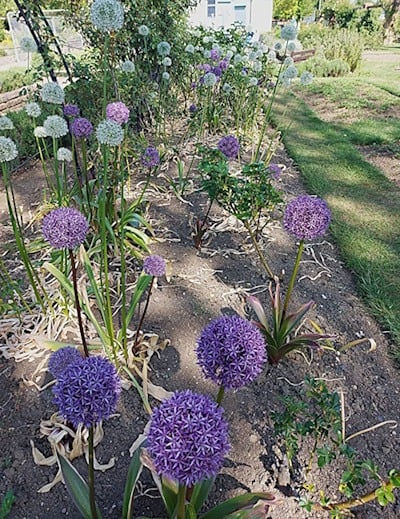
A common problem when growing Alliums is that the leaves tend to look tatty just as the Alliums are at their blooming best. This can detract from the wonderful show of their flowers.
This image well illustrates the point. The Alliums have been planted in bare earth, which exposes the tatty browning leaves.
This problem is easily overcome by companion planting. Rather than planting the Alliums into bare earth, surround the plant with suitable spring flowering plants and that way the neighbouring plants' foliage will discreetly cover up the Alliums brown leaves. There are ideas for some companion planting below, designed with this in mind.
Explore Stunning Allium varities for your garden
View this gallery of Allium varieties to find the perfect ones for your garden. You can find detailed names and descriptions below.
Allium christophii

Allium Globemaster
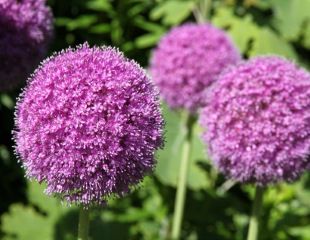
Allium sphaerocephalon
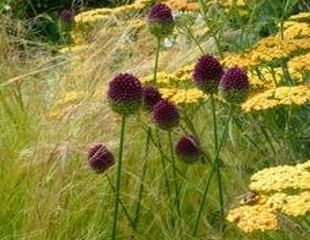
Allium 'White Giant'
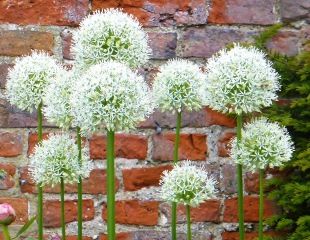
A. cristophii is short at 60cms with spiky violet flower heads made up of tiny star shaped flowers. It will self seed in the right conditions.
A. Globemaster is a tall variety up to 100 cm with large, deep purple flower heads up to 20cm across.
Allium sphaerocephalon is unusual as it is a late summer-flowering Allium. Planted here with Achillea and Deschampsia.
A 'White Giant', a lovely white variety up to 1.5m large flowers 10-15cm
Allium 'Pinball Wizard'
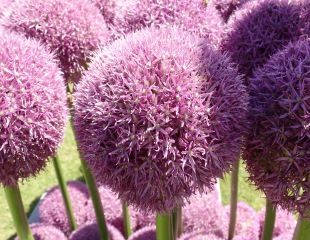
Allium schubertii
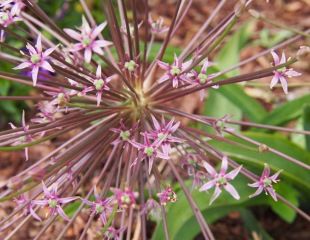
Blue Allium caeruleum
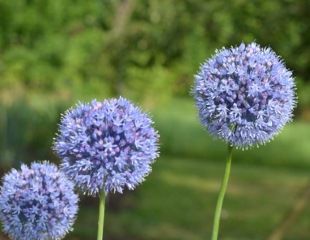
Allium nectaroscordum
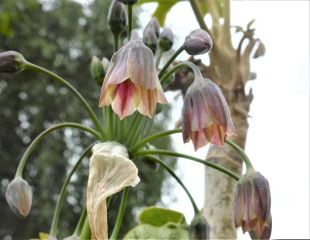
A. 'Pinball Wizard', another tall variety 60cm, flowers 20cm mauve with a more fluffy flower head.
A. Schubertii 60cms with large 30cms flower heads which are very spikey flowers resembling a starburst.
Blue Allium caeruleum a strong blue variety reaching between 60-80cm
Allium nectaroscordum is an unusual variety with nodding umbel flowers
What to plant with Alliums - Best Planting Combinations
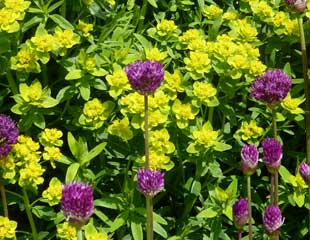
Allium 'Purple Sensation' with Euphorbia palustris
Allium 'Purple Sensation' with Euphorbia palustris which make a great contrasting combination. This is a late spring and early summer combination.
Both plants are low maintenance, making it an easy to grow combination.
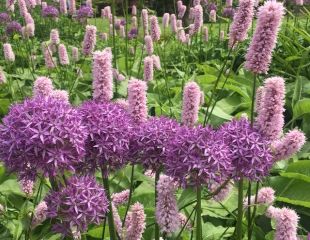
Allium with Persicaria bistorta 'Superba'
A great planting combination of Allium with pink Persicaria bistorta 'Superba'. Both plants are long flowering and will attract bees and butterflies. I took this image in the botanical garden at Leicester University, which has a fabulous display of Alliums from mid May onwards. (and it's free.)
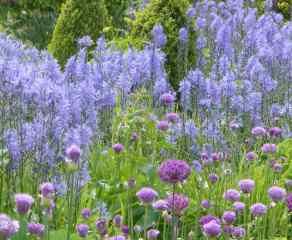
Blue spires of Camassia with purple Allium
Camassia with purple Allium- two bulbs grown together make a great late spring, early summer planting combination.
Bulbs are easy to grow and Camassia has lovely soft blue flowers which open from the base upwards. Camassia growing tips
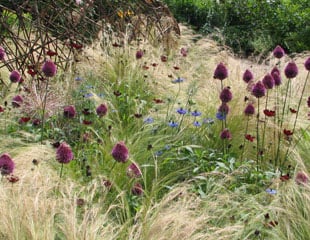
Allium sphaerocephalon, with
deschampsia Nigella
This is a late flowering combination from July onwards. Allium sphaerocephalon with fluffy grass deschampsia and the blue Nigella, the annual love-in-a-mist. I took this image at RHS Harlow Carr an impressive combination.
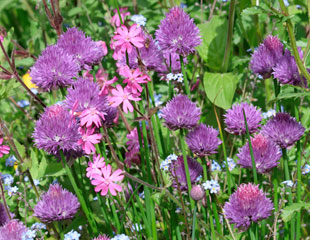
Chives, campion and forget-me-nots.
Wildlife friendly planting combination of Chives, campion and forget-me-nots. Bees just love Chives as the video above shows. They also make a great edging plant. Cut back after flowering for a second flush.
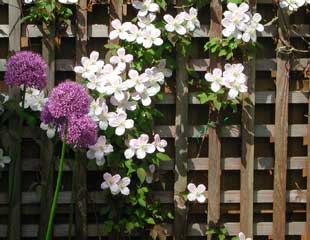
Allium combined with the early flowering Clematis montana
Purple Allium combined with soft creamy white of the early flowering Clematis montana.Ideal planted against a fence they make a lovely planting combination. C.montana is a group 1 for pruning so easy to grow.
The RHS always knows how to put on an impressive display and this is Alliums on mass with grasses growing at RHS Harlow Carr, something to aspire to.
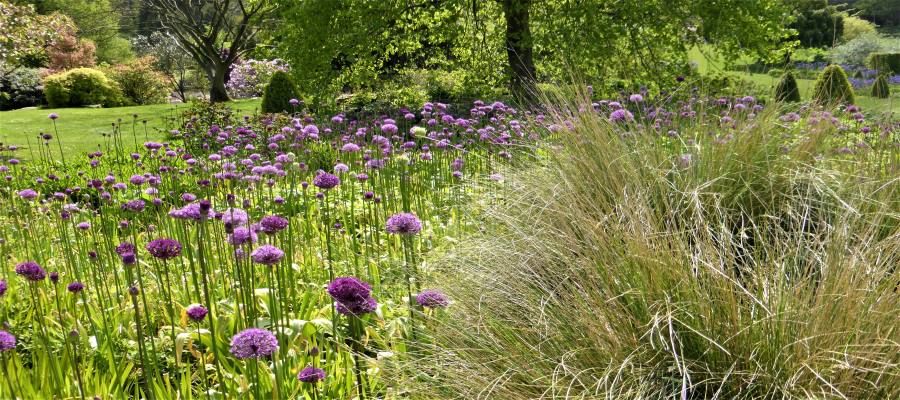
Lovely display also at the University of Leicester Botanic Gardens. Borders filled with Alliums and persicaria bistorta attracted a lot of pollinators and insects.
